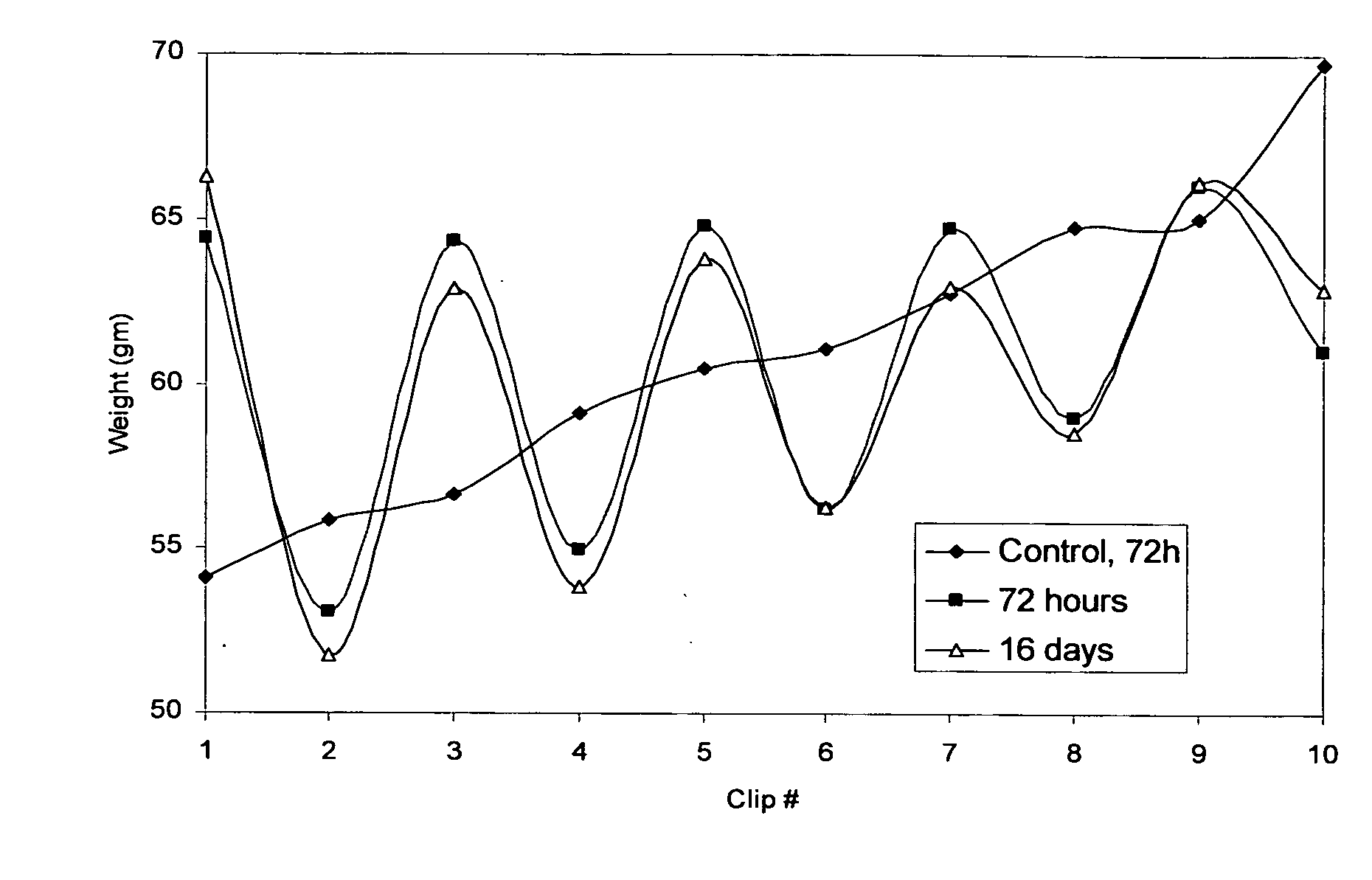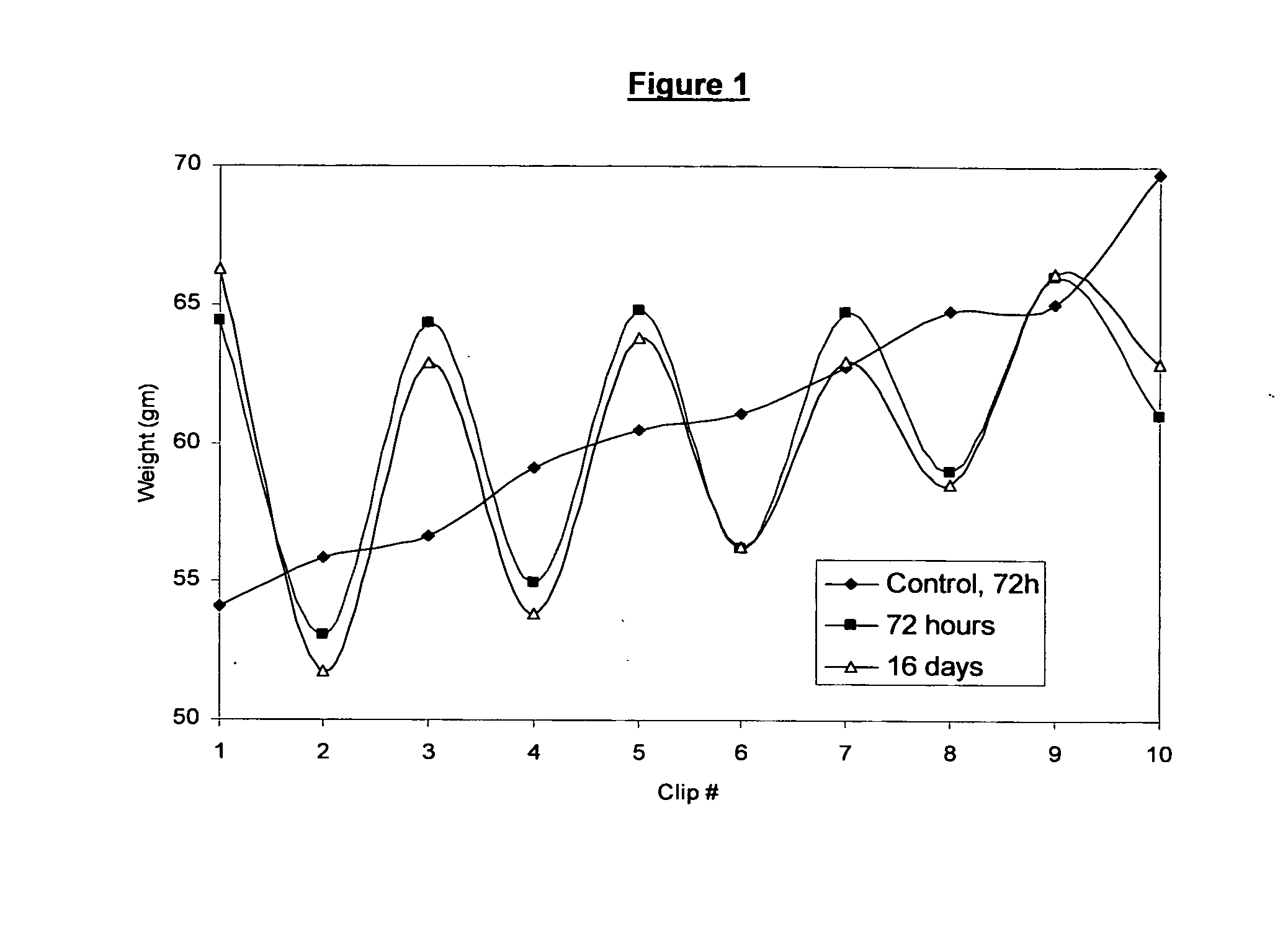Control of fluid migration in wet-wipes
a technology of wet wipes and fluids, applied in the field of wet wipe composition, can solve the problems of fluid migration in the container during storage, soggy and oversaturated bottom wipes, and the topmost wipes in the stack becoming too dry, and achieve the effect of improving fluid migration properties
- Summary
- Abstract
- Description
- Claims
- Application Information
AI Technical Summary
Benefits of technology
Problems solved by technology
Method used
Image
Examples
example 1
[0031]An example of a wet-wipe composition containing a binary mixture of sodium alginate and calcium chloride was produced. The wet-wipe composition used a commercially available conventional wet-wipe (Parent's Choice® wipes distributed through Wal-Mart Stores, Inc.) into which the binary pair of gelling polymer, sodium alginate, and gelling agent, calcium chloride, was added. The stack of conventional wet-wipes used in this example contained 80 wipes and consisted of 10 clips, each of which contained 8 wipes which could be easily separated. The stacks were squeezed on a Carver press (Carver Laboratory Press, Model 2518, available from Fred S. Carver Inc., Menomenee, Wis., 53051) to remove a substantial amount of the liquid portion of the conventional wet-wipe thereby reducing the stack weight of the conventional wet-wipes from its initial weight of approximately 610 grams to 330 grams. It was noted that the dry stack of 80 wipes weighed approximately 170 grams.
[0032]Following the ...
example 2
[0035]An example of a wet-wipe composition was produced where the gelling agent in the form of a dry salt (calcium chloride) was incorporated into a substrate and providing a liquid portion containing an effective amount of a gelling polymer (sodium alginate) which when added to the substrate comprising the gelling agent results in a wet-wipe composition having improved fluid migration properties.
[0036]A wet-wipe substrate (PET / Viscose / Cotton blend) was cut into 4″×7″ (10.2 cm×17.8 cm) sheets. CaCl2 was applied by spraying at 0.1 wt % solution to the sheets. The amount of applied CaCl2 salt solution was varied to achieve different salt concentrations on the sheets. The salt containing sheets were subsequently dried at 105° C. A sodium salt of alginic acid (Keltone® HVCR sodium salt of alginic acid, available from International Specialty Products) was applied as 0.3 wt % solution in a model baby wipe lotion to produce a wet-wipe composition. The wet wipe compositions were equilibrate...
example 3
[0039]A screening test was performed to determine whether addition of a calcium containing salt (calcium chloride) would adversely affect a latex emulsion used in substrate formation. This screening test is set forth below.
Determination of Coagulum (Dry Grits Method)
Purpose:
[0040]This procedure provides a method for determining the amount of coagulum (grits) on a dry basis as a percentage of an emulsion.
Apparatus / Materials:
[0041]U.S. Standard Sieves (3″ diameter, 100-mesh)[0042]Wash Bottle[0043]Aluminum Dish (60×15 mm)[0044]Top Loading Balance (0.1 g capability)[0045]Analytical Balance (0.0001 g capability)[0046]Air-Circulating Oven[0047]Desiccator[0048]1 Gallon Glass Jar
Preparation / Procedure
[0049]1. Fill a gallon jar with approximately 1 inch of room temperature water and tare the jar and water.[0050]2. Add 700 to 900 grams of emulsion into the tared glass jar. Weigh to the nearest 0.5 grams.[0051]3. Carefully add approximately 300 ml of room temperature water to the jar and swirl ...
PUM
| Property | Measurement | Unit |
|---|---|---|
| Area | aaaaa | aaaaa |
| Wettability | aaaaa | aaaaa |
Abstract
Description
Claims
Application Information
 Login to View More
Login to View More - R&D
- Intellectual Property
- Life Sciences
- Materials
- Tech Scout
- Unparalleled Data Quality
- Higher Quality Content
- 60% Fewer Hallucinations
Browse by: Latest US Patents, China's latest patents, Technical Efficacy Thesaurus, Application Domain, Technology Topic, Popular Technical Reports.
© 2025 PatSnap. All rights reserved.Legal|Privacy policy|Modern Slavery Act Transparency Statement|Sitemap|About US| Contact US: help@patsnap.com


